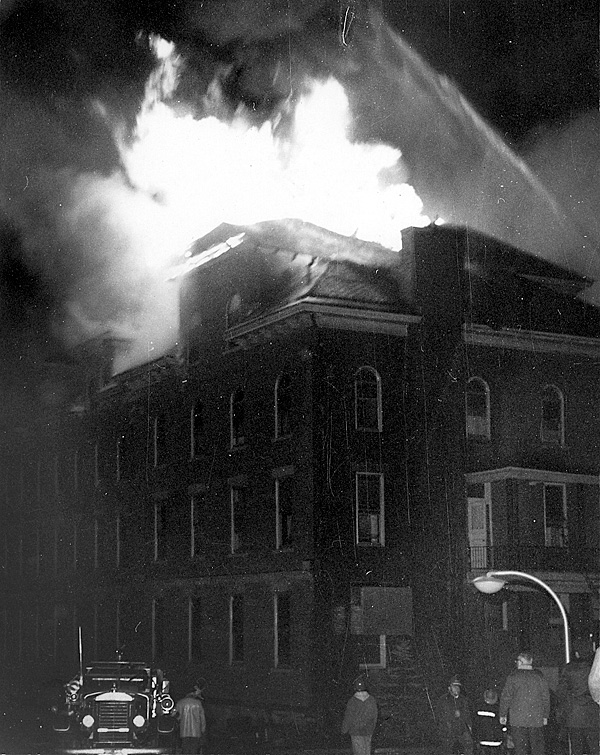Famous Landmark Destroyed
February 22, 1971 (Editorial)
 We think it safe to state as a matter of fact that no lay person can begin to measure either in dollars or in terms of sentimentality the loss that has befallen the sisters at Marywood. There are sisters in far off missions for whom the seminary building, and not the Marywood campus, was home. For some of them it was First Grade, Freshman Year, Graduating Class, Postulancy, Novitiate, Profession, Assignment to the Seminary, and a career of long years. The fire for some wiped out a lifetime.
We think it safe to state as a matter of fact that no lay person can begin to measure either in dollars or in terms of sentimentality the loss that has befallen the sisters at Marywood. There are sisters in far off missions for whom the seminary building, and not the Marywood campus, was home. For some of them it was First Grade, Freshman Year, Graduating Class, Postulancy, Novitiate, Profession, Assignment to the Seminary, and a career of long years. The fire for some wiped out a lifetime.
It was the mother house for a great order of dedicated religious women. To modern day pragmatists who figure it to have been the oldest building on campus, the structure that housed both a locally oriented high school for girls and a convent, the loss is measurable in dollars and in sentimental values. Not so to them who knew its beginnings and its purpose.
It was Mount Saint Mary's before there was a campus. There would have been no campus, no "College Street," no "Seminary Street," no "University Street," had there been no Mount St. Mary's.
It was, even originally, more than a convent. It was the beginning of a new order of sisters. One is not born a sister, not an I.H.M. sister anyhow, one is schooled and trained to be such a sister. When schooled and trained, there are places, yes Scranton back in 1900, Pittston, Kingston, Williamsport, Altoona, places in New Jersey and Long Island, places throughout eastern United States, later undoubtedly the mid-west, Oregon, and South America to which sisters so schooled and so trained would be sent. It was to be and actually became a far-flung religious enterprise with truly great administrative heads at its helm. Oh, someday maybe, someday much later, might there be a college but the purpose was missionary, children would be taught the ways of God and the elementary, mundane, sciences.
It would be, first and foremost, a seminary. The place where young women would become sisters. A great order was to be found to answer great needs for the founding of such an order.
A bit of hill to Scranton's north-east would do and, settled there, a thing began, grew, has ever since expanded, where now only structural debris is visible.
The fire is as if the Sisters Cyril, Immaculata, Leo, Gregory, and countless others, long dead, have, as it were, died anew.
In aspects religiously devotional, liturgical, Gregorian, and spiritual it knew no equal this side of Rome. Its chap was not merely a place of worship, it was almost a place to worship. Choirs of angels sand daily at daybreak. Still audible is the seemingly deliberate, well spaced words of Father, later Monsignor, McHugh's elevation - "Hoc . . . est . . . emm . . . corpus . . . meum."
The chapel was more than the structural center to and from which the fires spread. It long was the center to and from which the fire spread. It long was the center to and from which spiritual fires spread.
It's finished. It's gone. Gone, that is, are its works of art, its altar, its sacristy; gone its one-time kindergarten, its second-floor grades, its third floor high school to which came girls from foreign lands; gone the "refectory"; gone the high school dorms, the sisters' "cells"; gone the exquisite dining room; gone the gym; gone the east porch so latticed as to hide fledging religious novices in prayerful study, cut-off from public gaze; gone the front entrance to which, at door bell ring, a "portress" answered; gone - indeed - the home of the Sisters, Servants of the Immaculate Heart of Mary.
But they are, after all, a vibrant, forward-looking order. They have built to serve. Their service is, even now, in need. Consequently, they will rebuild.
Rebuild as they may - and they will rebuild well - , they will, to oldtimers, never succeed (and they dare not try) in replacing the old, glorious, resplendent, and, yes, quite functional mother house which this week disappeared as if providentially decreed.
Our sympathy to the sisters in this their hour of need.
